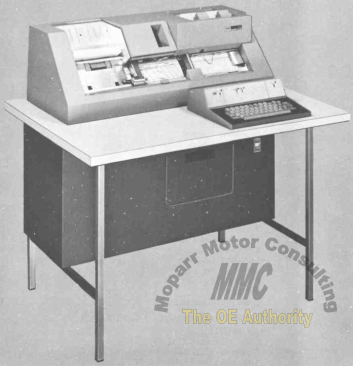Most cars built between1962 - 67 a photocopy of your IBM card can be obtained from the Chrysler Historical Society for $45.00. They typically provide you with a cover letter that identifies the name and address of the selling dealer.
From the Order and Production Card it is possible to extract factory-installed options, paint colors, date, even the key numbers.
Information that was applied to the card was used to create the vehicle option tag . Punched holes are on a line corresponding to a digit, 0 through 9. One can read all the numbers, or the last digit alone when the previous ones are supplied (special equipment numbers in red). Certain codes occur twice on the card, once written out, in another place punched (i.e., dealer code, trim item etc…)
Punch cards (UNIVAC® programmers would never refer to them as "IBM cards"!) were not only the primary medium used to create programs in the mainframe era,
In 1928, Hollerith's company, now renamed IBM, introduced the rectangular hole 80 column format. The overall dimensions of punched cards used for data processing have remained the same since Herman Hollerith invented the medium: 7 3/8 inches wide by 3 1/4 inches high by .007 inches thick.
Until the mid-1970s, most computer access was via punched cards. Programs and data were punched by hand on a key punch machine key punch machine and read into a card reader. By the mid 1970's, most large scale data processing operations were at least investigating moving their punched card operations to timesharing environments, with their data stored on disk or magnetic tape, and by the mid 1990's, with timesharing mainframes and personal computers, the shift was almost complete, with very few businesses still using cards for anything other than scratch paper.
 |
IBM 029 Key Punch Machine from the early 1960's |
|---|
The original punch cards (#5280 IBM-type computer punch cards) Each card contains 9 rows of 76 columns, and each column is typically used to represent a single piece of data such as a character. It is to be read from left to right.
Note: Option space= Hole punched out: (1-9 rows B=Blank or no punch)
|
#1 1
#2 2
#3 B
#4 6
#5 6
#6 8
#7 8
#8 7
#9 5
|
#40 B
#41 B
#42 B
#43 B
#44 B
#45 B
#46 B
#47 B
#48 B
#49 B
|
|
#10 1
#11 5
#12 7
#13 1
#14 4
#15 7
#16 B
#17 B
#18 B
#19 6
|
#50 9
#51 B
#52 3
#53 4
#54 2
#55 7
#56 9
#57 5
#58 8
#59 4
|
|
#20 1
#21 1
#22 B
#23 B
#24 B
#25 2
#26 2
#27 1
#28 3
#29 1
|
#60 3
#61 1
#62 7
#63 B
#64 6
#65 1
#66 4
#67 2
#68 1
#69 5
|
|
#30 9
#31 B
#32 B
#33 3
#34 B
#35 B
#36 B
#37 5
#38 B
#39 B
|
#70 1
#71 3
#72 8
#73 4
#74 1
#75 2
#76 1
|


